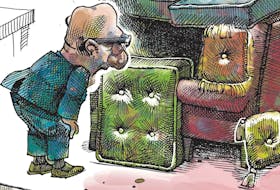This week the Canadian Medical Association Journal published an editorial urging the repeal of Section 43 of the Criminal Code of Canada — the so-called spanking law.
It is a shocking reminder that, in family-values Conservative Canada, assaulting children is still legal.
Section 43 outlines the rights of parents to mete out physical punishment to their kids. There are limits: no hits to the head; no excessive force; no weapons, such as belts or sticks; spankings cannot be habitual; punishment must be corrective; spanking is restricted to kids aged 2-12.
The provisos merely put a respectful veneer on actions that amount to assault.
The pro-spanking crowd got a boost when the Supreme Court of Canada outlined the provisions in 2004 after a legal challenge to Section 43.
In this case, justice was blind, in the worst sense.
Name one other group of people in society who are not legally protected against assault.
(“Hockey players,” says a smart aleck at the back, raising an interesting point, but not necessarily a serious rebuttal.)
Husbands are no longer allowed, obviously, to apply “corrective” physical coercion upon their wives, no matter how wayward or wanton the woman may be.
That “rule of thumb” stick of yesteryear would today get you hauled before a judge, buster, and rightfully so.
Police are limited in the force they can use. A suspect cannot be arbitrarily assaulted by officers; thus the relatively modern, in the annals of law enforcement, concept of “police brutality.”
Prisoners cannot be subjected to corporal punishment. Any prison warden who allowed “corrective” beatings or whippings would soon be on a new career path.
But children can be flailed
at, and the assaults are court-
sanctioned.
Arguments that favour retaining Section 43 are based on false assumptions.
A common error is equating discipline with physical punishment. Ban spanking, the argument goes, and parents will be denied a necessary tool for disciplining their children.
“Spare the rod and spoil the child,” and all that nonsense — a phrase from an era that also endorsed slavery.
Effective discipline of children does not require physical force.
What do children want and need most from parents? Love and approval.
Love is unconditional, so it is not part of the disciplinary equation. But approval and disapproval can be a tool far more powerful than spanking. A stern but loving “No” can be more corrective than any rod of yore.
But what to do about all those brats?
There are brats in the schools, brats in the streets, brats at the mall.
This is another fallacious argument: that the supposed decline of spanking and physical punishment has enabled wild children to run amok, unbridled and uncivilized.
No. What those children need is not spankings or smacks, but to hear the word “No” more often, and its variations, such as “Stop” and “Don’t.” Lessons in basic manners would also help.
Backers of Section 43 will scoff. And if the kid ignores the command? What then? In that case, the problem is with the parent, not the kid, and using physical force won’t help. You spawned a brat. Deal with it.
“But you can’t reason with toddlers,” is a common argument presented by the pro-spanking set.
Toddlers don’t comprehend the dangers of sharp knives, hot stoves or busy roads, goes the standard argument. Exactly. That’s why it is a parent’s job to keep toddlers away from them. The kid won’t comprehend why Mommy or Daddy is whacking him, either.
The Canadian Medical Association Journal editorial has it right: Section 43 is indeed an “anachronistic excuse for poor parenting.”
It should be smacked into oblivion.
Brian Jones is a desk editor at The Telegram. He can be reached at [email protected].








